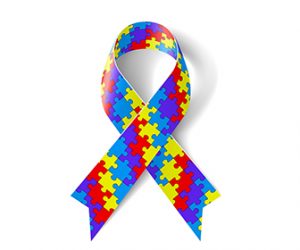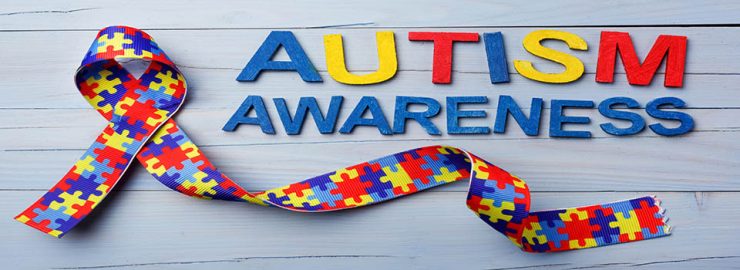What images and thoughts come to mind when you think of Autism? I’ll let that sit with you for a few minutes. April is Autism Awareness Month, kicked off by Autism Awareness Day on April 2nd. World Autism Awareness Day is an internationally recognized day on April 2nd every year. It encourages member states of the United Nations to take measures to raise awareness about people with Autism Spectrum Disorder (ASD) throughout the world. World Autism Awareness Day passed in council on November 1, 2007, and adopted on December 18, 2007.
The Autism Society refers to Autism Awareness Month as a “nationwide effort to promote autism awareness, inclusion and self-determination for all, and assure that each person with ASD is provided the opportunity to achieve the highest possible quality of life.”
 The puzzle piece has become the common symbol to represent ASD. The single blue puzzle piece and the puzzle ribbon are common symbols. The origin of the puzzle piece goes back to 1963. It was created by Gerald Gasson, a parent and board member for the National Autistic Society (formerly The Society for Autistic Children) in London. The continued use of the puzzle piece is controversial. The initial meaning is allegedly tied to believing autistic people suffered from a “puzzling” condition to how autistic people “fit” into society.
The puzzle piece has become the common symbol to represent ASD. The single blue puzzle piece and the puzzle ribbon are common symbols. The origin of the puzzle piece goes back to 1963. It was created by Gerald Gasson, a parent and board member for the National Autistic Society (formerly The Society for Autistic Children) in London. The continued use of the puzzle piece is controversial. The initial meaning is allegedly tied to believing autistic people suffered from a “puzzling” condition to how autistic people “fit” into society.
The blue puzzle piece is associated with The Autism Speaks Puzzle Piece Project which uses the single puzzle piece symbol to teach autism awareness in schools. It’s designed to act as a springboard for conversation about autism and to increase awareness about ASD among peers of kids on the spectrum.
 The puzzle ribbon was adopted in 1999 as the universal sign of autism awareness. The puzzle pattern reflects the complexity of the autism spectrum. The different colors and shapes represent the diversity of the people and families living with the condition. The brightness of the ribbon signals hope — hope that through increased awareness of autism, and through early intervention and access to appropriate services/supports, people with autism will lead full lives able to interact with the world on the own terms. (courtesy of Autism Society)
The puzzle ribbon was adopted in 1999 as the universal sign of autism awareness. The puzzle pattern reflects the complexity of the autism spectrum. The different colors and shapes represent the diversity of the people and families living with the condition. The brightness of the ribbon signals hope — hope that through increased awareness of autism, and through early intervention and access to appropriate services/supports, people with autism will lead full lives able to interact with the world on the own terms. (courtesy of Autism Society)
Now that you’ve had a few minutes to think, what comes to mind when you think of autism? Compare it to Autism Speaks’ 11 Myths about Autism.
- Myth: People with autism don’t want friends.
Truth: If someone in your class has autism, they probably struggle with social skills, which may make it difficult to interact with peers. They might seem shy or unfriendly, but that’s just because he or she is unable communicate their desire for relationships the same way you do. - Myth: People with autism can’t feel or express any emotion—happy or sad.
Truth: Autism doesn’t make an individual unable to feel the emotions you feel, it just makes the person communicate emotions (and perceive your expressions) in different ways. - Myth: People with autism can’t understand the emotions of others.
Truth: Autism often affects an individual’s ability to understand unspoken interpersonal communication, so someone with autism might not detect sadness based solely on one’s body language or sarcasm in one’s tone of voice. But, when emotions are communicated more directly, people with autism are much more likely to feel empathy and compassion for others. - Myth: People with autism are intellectually disabled.
Truth: Often times, autism brings with it just as many exceptional abilities as challenges. Many people with autism have normal to high IQs and some may excel at math, music or another pursuit. - People with autism are just like Dustin Hoffman’s character in Rain Man.
Truth: Autism is a spectrum disorder, meaning its characteristics vary significantly from person to person. Knowing one person with autism means just that—knowing one person with autism. A person’s capabilities and limitations are no indication of the capabilities and limitations of another person with autism. - Myth: People who display qualities that may be typical of a person with autism are just odd and will grow out of it.
Truth: Autism stems from biological conditions that affect brain development and, for many individuals, is a lifelong condition. - Myth: Autism only affects children.
Truth: Children with autism grow up to become adults with autism. - Myth: Autism is just a brain disorder.
Truth: Research has shown that many people with autism also have co-occurring conditions like epilepsy, gastro-intestinal disorders, food sensitivities, and many allergies. - Myth: Autism is caused by bad parenting.
Truth: In the 1950s, a theory called the “refrigerator mother hypothesis” arose suggesting that autism was caused by mothers who lacked emotional warmth. This has long been disproved. - Myth: The prevalence of autism has been steadily increasing for the last 40 years.
Truth: The prevalence of autism has increased by 600% in the last 20 years. In 1975, an estimated 1 in 1,500 had autism. In 2014, an estimated 1 in 59 had an autism spectrum disorder. - Myth: Therapies for people with autism are covered by insurance.
Truth: Many insurance companies exclude autism from the coverage plan. 48 of the 50 U.S. states have passed some form of autism insurance coverage laws thanks to the work of advocates.


















Add comment